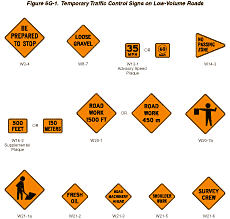Chapter 5G. Temporary Traffic Control Zones
Section 5G.01 Introduction
Guidance:
The safety of road users, including pedestrians and bicyclists,
as well as personnel in work zones, should be an integral and high
priority element of every project in the planning, design, maintenance,
and construction phases. Part 6
should be reviewed for additional criteria, specific details, and
more complex temporary traffic control zone requirements. The following
principles should be applied to temporary traffic control zones:
- Traffic movement should be disrupted as little as possible.
- Road users should be guided in a clear and positive manner while approaching and within construction, maintenance, and utility work areas.
- Routine inspection and maintenance of traffic control elements should be performed both day and night.
- Both the contracting agency and the contractor should assign at least one person on each project to have day-to-day responsibility for assuring that the traffic control elements are operating effectively and any needed operational changes are brought to the attention of their supervisors.
Traffic control in temporary traffic control zones should be designed on the assumption that road users will only reduce their speeds if they clearly perceive a need to do so, and then only in small increments of speed. Temporary traffic control zones should not present a surprise to the road user. Frequent and/or abrupt changes in geometrics and other features should be avoided. Transitions should be well delineated and long enough to accommodate driving conditions at the speeds vehicles are realistically expected to travel.
A Traffic Control Plan (see Section 6C.01) should be used for a temporary traffic control zone on a low-volume road to specify particular traffic control devices and features, or to reference typical drawings such as those contained in Part 6.
Support:
Applications of speed reduction countermeasures and enforcement
can be effective in reducing traffic speeds in temporary traffic
control zones.
Section 5G.02 Applications
Guidance:
Planned work phasing and sequencing should be the basis for the
use of traffic control devices for temporary traffic control zones.
Part 6 should be consulted for specific traffic control requirements
and examples where construction or maintenance work is planned.
Option:
Maintenance activities may not require extensive temporary traffic
control if the traffic volumes and speeds are low. The traffic applications
shown in Figures 6H-1,
6H-11,
6H-15,
and 6H-16
of Part 6 are among those that may be used on low-volume roads.
For temporary traffic control zones on low-volume roads that require flaggers, a single flagger may be adequate if the flagger is visible to approaching traffic from all appropriate directions.
Section 5G.03 Channelization Devices
Standard:
Channelization devices for nighttime use shall have the same retroreflective
requirements as specified for higher-volume roadways.
Option:
To alert, guide, and direct road users reasonably safely through
temporary traffic control zones on low-volume roads, tapers may
be used to move a road user out of the traffic lane and around the
work space using the spacing of devices that is described in Section
6F.58.
Section 5G.04 Markings
Guidance:
Pavement markings should be considered for temporary traffic control
zones on paved low-volume roads, especially roads that had existing
pavement markings or that have a surfaced detour or temporary roadway.
Option:
Interim pavement markings in a temporary traffic control zone may
not be needed based on the criteria for these markings in Section
6F.72.
Section 5G.05 Other Traffic Control Devices
Standard:
Other traffic control devices, such as other signs, signals, and
illumination that are used on low-volume roads in temporary traffic
control zones, but are not described in Part 5, shall conform with
the criteria contained in other Parts of this Manual.
Support:
Some of the signs that might be applicable in a temporary traffic
control zone on a low-volume road are shown in Figure 5G-1.
Figure 5G-1 Temporary Traffic Control Signs on Low-Volume Roads

